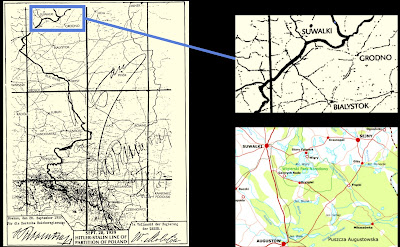My parents last Summer in Poland, the year 1968, the year when an infamous anti-Semitic campaign took place in Poland and Polish Korczak Society was closed. My parents were (almost) on their way to Sweden. They just applied for the emigration permit according to "Gomulka rules". I send them from Sweden two cars so the emigration would be financially easier. I was, however, surprised when their first Mercedes trip outside Warsaw was to Sejny. The name Sejny was not known by me at that time.
I thought that the reason for leaving Warsaw for Sejny was just cutting the communication with all the problems concerned with the emigration and antisemitism there.
When driving to Augustów my parents passed Treblinka, our biggest family cemetery. Almost all Rozentals, Polirsztok and Wójcikiewicz ashes are there among almost 1 million others.
I do not know if they stopped. I do not think so as they wanted to have rest, rest of their minds.
They rented some rooms just outside Sejny at the Polish farmer's house. My father was happy to work in the fields as it was the harvest time. The Polish farmers were very nice and asked my parent for one particular favor: the wanted to get a ride on Sunday to the local church in Mercedes. One of my brothers drove them next Sunday!
Later when both my parents passed, I found that my mothers grand-grandfather lived in Sejny. So Sejny was chosen not by accident. I think that he was blacksmith there.
My mothers' grandfather Alfred Rozental was born in a small village (Shtetl) of Sejny near Suwalki (or maybe in Suwalki in North-Eastern Poland, where his father was a blacksmith and also leased a fish pond. There was only a 4-grade school nearby, so he went to live with his uncle (a tailor) and became his apprentice. At age 17, Alfred Rozental left for Warsaw (on foot), where he became a tailor. He was pretty successful at his trade, had a shop on 139 Marszalkowska Street (prime location), and his clients included the military officers.
Alfred married a Polish Catholic woman from Suwałki (Yiddish: סואוואַלק), the future mother of Gabriel (my grandfather) and his sister Renia. This might be where the Rozental family acquired its blond/blue genes, which then helped my mother and her sister Krystyna to survive the Holocaust]. The Polish woman - wife of Alfred (we don't know her name) was apparently educated, and she did some book-keeping and clerical work at the shop in Warsaw. However, she died young, and Alfred remarried. He and his second wife (who was Jewish) had two children: Piotr (b. 1900) and Lenora. Alfred was murdered in Treblinka. Leonora and her son Alfred jr born in Paris in Auschwitz
Now, if Alfred went to Warsaw and had a fancy shop on Marszalkowska Street, why was his son, Gabriel Rozental (my grandfather), born in Sejny in 1893? Back to the undeveloped area of Poland, later called Poland B. It makes no sense!
Sejny is about 45 kilometers from Augustow and only a few kilometers from Lithuania and Belarus border. During the beginning of WWII on September 24, 1939, the town was first captured by the Soviet Union and then on October 13, 1939, transferred to Nazi Germany. Thick, black division line on the map of Molotov–Ribbentrop Pact, also known as the Hitler–Stalin Pact, was the reason for that. Similar movements of the German and Soviet armies are known along the entire line. Many photos of Russians and Germans "happy together" were taken at this occasion.
Sejny remained occupied by the Germans for the rest of World War II, which resulted in the almost complete destruction of the local Jewish community. On August 31, 1944, the town was liberated by the Red Army and belongs to Poland's since that.
 |
| Thick, black division line on the map of Molotov–Ribbentrop Pact, also known as the Hitler–Stalin Pact, was the reason for that Sejny was first captured by Red Army and returned to Germans. |
What is left of the former Jewish Sejny? The synagogue called the White Synagogue and Yeshiva, built around 1850. It is today is used as a concert hall. There is also Jewish cemetery and the monument, memory stone from present Sejny inhabitants.
The Synagogue is a large, Neo-baroque style building on Pilsudskiego Street was erected in the 1860s, replacing an older building. It was used by the Nazis as a fire station, the interior was gutted and all the furnishings were destroyed. It was restored - with a plain, modern interior - in 1987 and now serves as a cultural center, theater, and museum.
 |
| Synagogue and Yeshiva (on the left) in Sejny, Poland c. 1911 |



